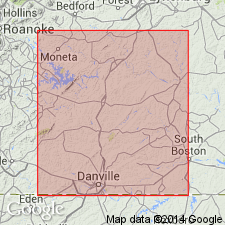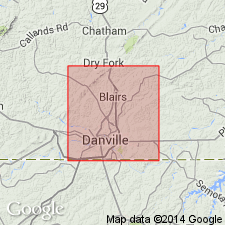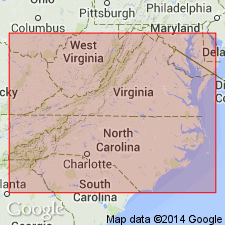
- Usage in publication:
-
- Dry Fork Formation
- Modifications:
-
- Named
- Dominant lithology:
-
- Graywacke
- Arkose
- AAPG geologic province:
-
- Piedmont-Blue Ridge province
- Dan River-Danville basin
Summary:
The Dry Fork Formation is here named for graywacke and arkose in the central and south central parts of the Danville basin, VA. The graywacke facies consists of poorly sorted, gray-green conglomerate and sandstone; the arkosic facies consists of sandstone, shale, and conglomerate and intertongues with both members of the Leakesville Formation. Disconformably underlies the Cedar Forest Formation. Thickness of arkosic facies at type section is 1,593 ft (480 m). Age is Late Triassic.
Source: GNU records (USGS DDS-6; Reston GNULEX).

- Usage in publication:
-
- Dry Fork Formation
- Modifications:
-
- Revised
- AAPG geologic province:
-
- Piedmont-Blue Ridge province
- Dan River-Danville basin
Summary:
The Dry Fork Formation is here revised to include basin margin conglomerate previously assigned to the Cedar Forest Formation. The Cedar Forest Formation is abandoned. Detailed mapping shows that the conglomerate is interbedded and intertongues with sandstone of the Dry Fork and that the Dry Fork and Cedar Forest are lateral facies equivalents. The Dry Fork is divided into intertonguing sandstone, mudrock, and conglomerate facies. On both sides of the Danville basin the Dry Fork rests unconformably on or is in fault contact with older rocks.
Source: GNU records (USGS DDS-6; Reston GNULEX).

- Usage in publication:
-
- Dry Fork Formation*
- Modifications:
-
- Areal extent
- AAPG geologic province:
-
- Piedmont-Blue Ridge province
- Dan River-Danville basin
Summary:
In the southwestern part of the Brosville quad., Danville basin, VA, Triassic rocks are divided into the Pine Hall, Cow Branch, and Stoneville Formations. The Cow Branch forms the reference beds for this division of rocks. Where the Cow Branch is absent there is no basis for distinguishing more than a single unit, the equivalent Dry Fork Formation.
Source: GNU records (USGS DDS-6; Reston GNULEX).

- Usage in publication:
-
- Dry Fork Formation
- Modifications:
-
- Biostratigraphic dating
- AAPG geologic province:
-
- Piedmont-Blue Ridge province
- Dan River-Danville basin
Summary:
Age of the Dry Fork Formation is middle and late Carnian on the basis of pollen and spore assemblages in the Cow Branch Formation.
Source: GNU records (USGS DDS-6; Reston GNULEX).
For more information, please contact Nancy Stamm, Geologic Names Committee Secretary.
Asterisk (*) indicates published by U.S. Geological Survey authors.
"No current usage" (†) implies that a name has been abandoned or has fallen into disuse. Former usage and, if known, replacement name given in parentheses ( ).
Slash (/) indicates name conflicts with nomenclatural guidelines (CSN, 1933; ACSN, 1961, 1970; NACSN, 1983, 2005, 2021). May be explained within brackets ([ ]).

